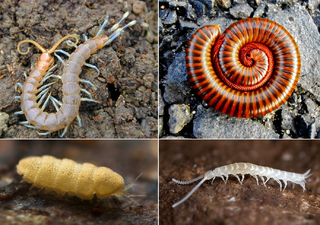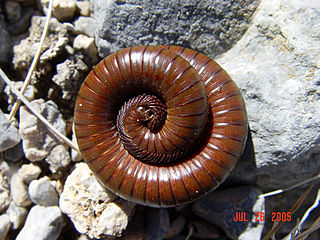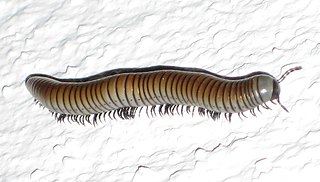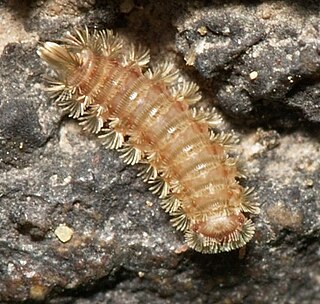
Millipedes are a group of arthropods that are characterised by having two pairs of jointed legs on most body segments; they are known scientifically as the class Diplopoda, the name derived from this feature. Each double-legged segment is a result of two single segments fused together. Most millipedes have very elongated cylindrical or flattened bodies with more than 20 segments, while pill millipedes are shorter and can roll into a tight ball. Although the name "millipede" derives from the Latin for "thousand feet", no species was known to have 1,000 or more until the discovery of Eumillipes persephone, which can have over 1,300 legs. There are approximately 12,000 named species classified into 16 orders and around 140 families, making Diplopoda the largest class of myriapods, an arthropod group which also includes centipedes and other multi-legged creatures.

Myriapods are the members of subphylum Myriapoda, containing arthropods such as millipedes and centipedes. The group contains about 13,000 species, all of them terrestrial.

Pill millipedes are any members of two living orders of millipedes, often grouped together into a single superorder, Oniscomorpha. The name Oniscomorpha refers to the millipedes' resemblance to certain woodlice (Oniscidea), also called pillbugs or "roly-polies". However, millipedes and woodlice are not closely related ; rather, this is a case of convergent evolution.
Pierre Marie Arthur Morelet was a French naturalist, born in Lays, Doubs. He was a member of the Commission to Algeria, primarily as a natural artist, drawing any natural findings. He collected specimens in the Canary Islands, Guatemala and Mexico.
The Department of Primary Industries and Regional Development (DPIRD) is a Western Australian government department responsible for regulating and advancing agricultural and food industries, fisheries and regional development within the state. It was formed by an amalgamation of the Department of Agriculture and Food, Department of Fisheries and Department of Regional Development in 2017.

Morelet's crocodile(Crocodylus moreletii), also known as the Mexican crocodile or Belize crocodile, is a modest-sized crocodilian found only in fresh waters of the Atlantic regions of Mexico, Belize and Guatemala. It usually grows to about 3 metres (10 ft) in length. It is a Least Concern species. The species has a fossil record in Guatemala.
Xiphinema index, the California dagger nematode, is a species of plant-parasitic nematodes.

Polydesmida is the largest order of millipedes, containing approximately 3,500 species, including all the millipedes reported to produce hydrogen cyanide (HCN).

Sphaerotheriida is an order of millipedes in the infraclass Pentazonia, sometimes known as giant pill millipedes. They inhabit Southern Africa, Madagascar, South and Southeast Asia, Australia and New Zealand. Like the Northern Hemisphere pill millipedes of the order Glomerida, these millipedes can roll into a ball when disturbed. When they are rolled-up, most sphaerotheriidans reach a maximum size of a cherry or golf ball, but some species from Madagascar can even reach the size of an orange. When rolled-up, predators are unable to unravel giant pill millipedes since the margins of their second and last dorsal plates fit perfectly into one another, creating a sealed ball. A few giant pill millipede species are able to produce sound, the only millipedes known to do this. This order of millipedes is also unique in that some African species are used for medicinal purposes.

Orthoporus ornatus is a North American species of millipede in the family Spirostreptidae that can be found in the U.S. states of Arizona, New Mexico and Texas, and as far south as the Mexican state of San Luis Potosí. They became very popular in the pet trade and many were exported to Western Europe. Brian Van Der Kieft and Max Prins were the first breeders of this species in Europe. Individuals on average are 4 inches (10 cm) in length, but can either be as small as 3 inches (76 mm), or exceed up to 9 inches (230 mm) in length. They are dark brownish coloured, but can sometimes be yellow. In fact, in every state the species look different. The antennae are located near the organs of Tömösváry. The species feed on both living and dead organic material. The species prefer sunshine, but can be seen on summer rainy days as well. A disturbed Orthoporus ornatus may curl into a coil and release a toxic substance that is located on all sides of its body. The species can live more than ten years. The species feed on shrubs of Ephedra, which grows in Jornada del Muerto, and on Salsola that grows in Albuquerque.

Ommatoiulus is a genus of millipedes in the family Julidae.

Polyxenida is an order of millipedes readily distinguished by a unique body plan consisting of a soft, non-calcified body ornamented with tufts of bristles – traits that have inspired the common names "bristly millipedes" or "pincushion millipedes". There are at least 86 species in four families worldwide, and are the only living members of the subclass Penicillata.

Anadenobolus monilicornis, known as the yellow-banded millipede or bumble bee millipede, is a species of millipede in the family Rhinocricidae. It is native to the Caribbean and has also been introduced to the southeastern United States.

Dalodesmidae is a family of millipedes in the order Polydesmida, containing at least 250 species found in the Southern Hemisphere.

Chordeumatida is a large order of millipedes containing some 1200 species with a nearly worldwide distribution. Also known as "sausage millipedes," they possess around 30 body segments behind the head as adults and reach about 25 mm (0.98 in) in length.

Siphoniulus is a poorly known genus of millipede containing only two living species: S. alba from Indonesia, and S. neotropicus from Mexico and Guatemala. An additional two fossil species are known from Cretaceous amber. Siphoniulus species are the only members of the family Siphoniulidae and order Siphoniulida, making Siphoniulida the smallest millipede order. Few specimens are known, and their classification is contentious, although most recent studies place them as basal members of the Helminthomorpha.

Casimir Albrecht Willem Jeekel (1922–2010) was a Dutch myriapodologist and entomologist known for his major contributions to the taxonomy of millipedes. His 1971 monograph Nomenclator Generum et Familiarum Diplopodorum is credited as launching the "modern era" of millipede taxonomy, and has been considered the "most important single work ever published on the Diplopoda". He served as director of the Zoological Museum Amsterdam, and authored over 150 works on the taxonomy of millipedes and other myriapods.

Ommatoiulus avatar is a species of European millipede in the family Julidae. Individuals are known from Andalusia, southern Spain. Individuals are 25 to 38 mm long. Color in alcohol preserved specimens is brownish with yellowish and black marbling on the dorsal surface. O. avatar was described in 2015, with the aid of X-ray microtomography that produced a three-dimensional digital model, becoming the first millipede described from reference to physical type specimens as well as virtual models, known as "cybertypes".

Anoplodesmus saussurii is a species of millipedes in the family Paradoxosomatidae. It was once thought endemic to Sri Lanka, but it was later found in Fiji and Mauritius.

Metopidiotrichidae is a family of millipedes in the order Chordeumatida. These millipedes range from 4 mm to 17 mm in length. Adult millipedes in this family have 32 segments, not the 30 segments usually found in this order. Adult males in this family often feature a reduced or vestigial leg pair 10 as part of the gonopod complex, in addition to the two leg pairs typically modified into gonopods in this order. There are about 9 genera and at least 70 described species in Metopidiotrichidae.

















